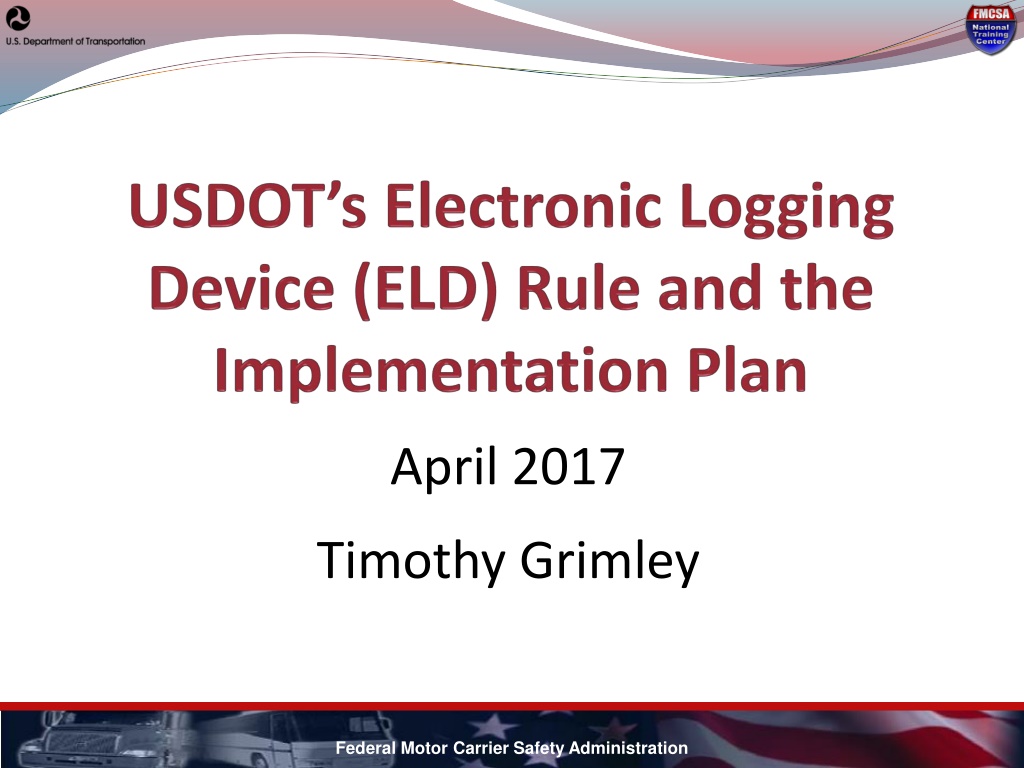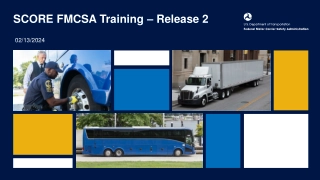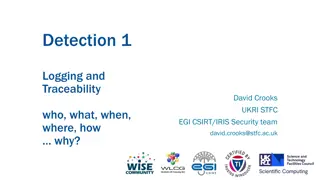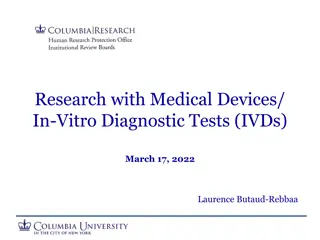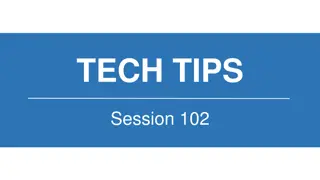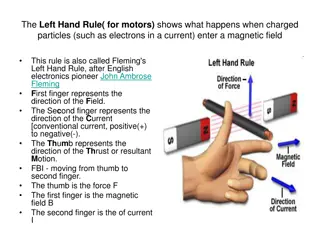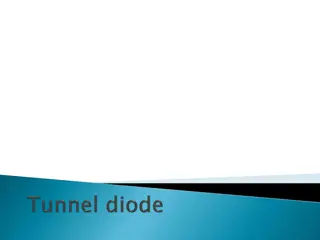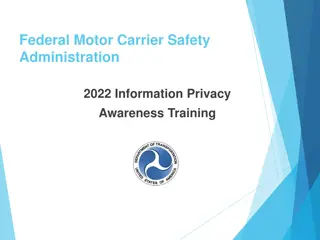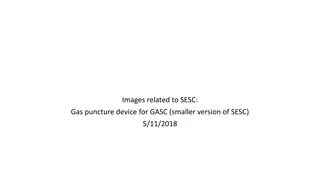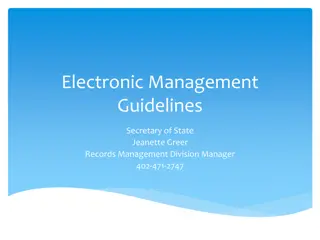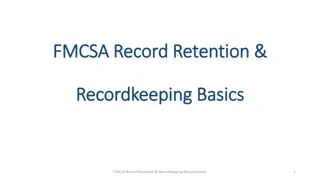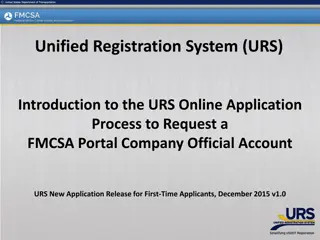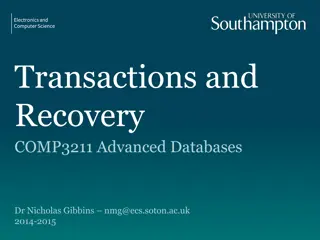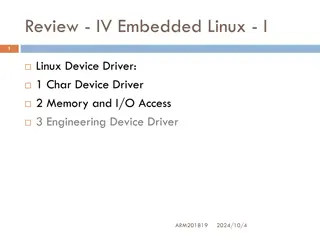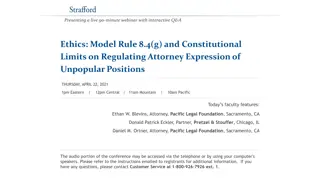Understanding FMCSA's Electronic Logging Device Rule
This content provides a detailed overview of the Electronic Logging Device (ELD) Rule by the Federal Motor Carrier Safety Administration (FMCSA). It covers the major components of the rule, ELD implementation phases, specifications, exemptions, who is required to use an ELD, awareness and transition phases, important dates, and information about Automatic On-Board Recording Devices (AOBRD) and logging software. The content includes images and descriptions to explain key concepts.
Download Presentation

Please find below an Image/Link to download the presentation.
The content on the website is provided AS IS for your information and personal use only. It may not be sold, licensed, or shared on other websites without obtaining consent from the author. Download presentation by click this link. If you encounter any issues during the download, it is possible that the publisher has removed the file from their server.
E N D
Presentation Transcript
April 2017 Timothy Grimley Federal Motor Carrier Safety Administration
Purpose Provide an overview of the Electronic Logging Device (ELD) Rule and FMCSA s plan for its phased implementation Major components of the ELD Rule ELD Implementation Phases ELD Specifications Myths and Industry Concerns 2 Federal Motor Carrier Safety Administration
Major Components of ELD Rule Requirements for the mandatory use of ELDs by most drivers currently required to prepare Record of Duty Status (RODS) Minimum performance and design standards (Technical Specifications) for ELDs 3 Federal Motor Carrier Safety Administration
Who is required to use an ELD? Interstate CMV drivers currently required to keep RODS Subject to requirements in 49 CFR 395 CMVs defined in 49 CFR 390.5 10,001 pounds Placarded hazmat More than 8 or 15 passengers 4 Federal Motor Carrier Safety Administration
Exemptions 100 air-mile radius drivers may continue to use timecards, as allowed by 395.1(e)(1) 150 air-mile radius non-CDL freight drivers may continue to use timecards, as allowed by 395.1(e)(2) Using paper RODS for not more than 8 days during any 30-day period Conducting drive away-tow away operations Driving vehicles manufactured before model year 2000 5 Federal Motor Carrier Safety Administration
Awareness and Transition Phase February 16, 2016 December 18, 2017 6 Federal Motor Carrier Safety Administration
Important Dates Registration and voluntary use of ELDs has begun (Started February 16, 2016) Compliance date is 2 years after ELD Rule is published (December 18, 2017) AOBRDs must be upgraded or replaced with ELDs within 4 years of the publication of the Final Rule (December 16, 2019) I.e., AOBRDs compliant with 395.15 that were installed before the compliance date could be used (grandfathered) for 2 years after the compliance date 7 Federal Motor Carrier Safety Administration
Automatic On-Board Recording Device (AOBRD) and Device with Logging Software and Applications AOBRD (49 CFR 395.2) Integrally Synchronized (Connects to Truck) Automatically records drivers driving status Acceptable until December 16, 2019 Device with Logging Software and Application Not Integrally Synchronized (No Connection to Truck) Manually input driving duty status or use GPS/Cell location only Not Acceptable after December 18, 2017 8 Federal Motor Carrier Safety Administration
Phase 1: Awareness and Transition System providers register and certify their ELDs the process is outlined on FMCSA s website Motor Carriers can choose to voluntarily use ELDs, AOBRDs, Devices with Logging Software Programs, or paper logs to record duty status Authorized safety officials need to distinguish the different types of devices and cite the appropriate regulation or guidance for enforcement purposes Harassment Legal Procedures 9 Federal Motor Carrier Safety Administration
Definition and Specifications 10 Federal Motor Carrier Safety Administration
What is an ELD? A device that: Automatically records a driver s driving time Facilitates the accurate recording of the driver s HOS Meets the technical specifications of the ELD rule Is integrally synchronized with the engine of the commercial motor vehicle (CMV) 11 Federal Motor Carrier Safety Administration
ELD Minimum Technical Standards Generally based on performance maximize flexibility, minimize cost Standard outputs for a consistent enforcement Include minimum output requirements for electronically transferred, displayed, and printed ELD information and output Appendix A to Subpart B of Part 395 12 Federal Motor Carrier Safety Administration
Engine Synchronization Integral synchronization to the engine control module (ECM) Monitoring of the vehicle s engine operation to automatically capture: Engine s power status Vehicle s motion status Miles driven Engine hours 13 Federal Motor Carrier Safety Administration
Automatically Recorded Data Date Time CMV Geographic Location Information Engine Hours Vehicle Miles Driver or Authenticated User Identification Vehicle Identification Motor Carrier Identification 14 Federal Motor Carrier Safety Administration
ELD Event Data Recordings Engine power up and shut down Driver login/logout Duty status changes Personal use or yard moves Certification of driver s daily record 60-minute intervals when the vehicle is in motion Malfunction of diagnostic events 15 Federal Motor Carrier Safety Administration
Geolocations CMV Geographic Location Information Show a nearby city, town, or village, or the compass direction and distance from the nearest city, town, or village 16 Federal Motor Carrier Safety Administration
Manual Inputs Motor carriers User account setup Drivers Support personnel (mechanics, dispatch, etc.) Drivers Annotations, when applicable Location description, when prompted by the ELD CMV power unit number Trailer number(s), if applicable Shipping document number, if applicable 17 Federal Motor Carrier Safety Administration
Data Diagnostics and Malfunctions ELD identifies data diagnostics and malfunctions with status as either detected or cleared for: Power Engine Synchronization Timing Positioning Data Recording Data Transfer Unidentified Driver Records 18 Federal Motor Carrier Safety Administration
ELD Myths and FAQs Myth ELDs will give the government 24-7 instant access to all our equipment and will instantly notify the government where our drivers are at all times and tell them about all violations in real time Fact ELD data is not sent to DOT in real time. It is only requested during a roadside inspection (in that case, only for the specific driver and prior 7 days) or during an FMCSA compliance investigation. 19 Federal Motor Carrier Safety Administration
Air Versus Bus/Trucking Oversight AIR BUS/TRUCKING ANNUAL TRIPS 650 million 750 million COMPANIES 6,900 525,000 total (truck and bus) PILOTS/DRIVERS 618,000 3.5 million (total) STAFF 4,000 321 Investigators 131 Inspectors 43 Auditors Total = 495 Inspectors
ELD Myths and FAQs Myth FMCSA is not certifying vendors. There s no way I will be able to buy a device in time to comply. Fact FMCSA currently has 34 certified ELD devices on our website. Many legacy AOBRD providers are awaiting FMCSA to release EROD software before certifying their devices. Many AOBRD providers are advising their devices can be turned into ELD s with a simple over the air update. Regardless of an update, AOBRD s installed now will be grandfathered in as compliant until 12/16/2019. 21 Federal Motor Carrier Safety Administration
ELD Myths and FAQs Myth ELD s are way too expensive. The cost of implementing them will drive me out of business Fact FMCSA did a cost benefit analysis and found that For carriers that already comply with existing hours of service limits , the cost of installation of ELD s will be offset by money saved through productivity gains from drivers having to fill out less paperwork, and less time spent by the carrier s office staff collecting, verifying, and storing paper logs. Many new devices can be installed in minutes versus older electronic log technology and work with existing tablets and smartphones. ELD s offer other telematics , like intelligent dispatch, that can save even more money. 22 Federal Motor Carrier Safety Administration
How Mobile ELDs Work Cellular 23
ELD Myths and FAQs Myth The ELD rule will never actually go into effect. FMCSA has tried this before and it s always overturned. All I have to do is wait this out. Fact While there is always a chance a new rule can be delayed for various reasons, the ELD rule was mandated by congress and was not an internal rulemaking the agency just decided to implement on its own. Previous attempts at ELOG regulations had been overturned by court rulings, but all court rulings to date have upheld the new ELD rule. At this point, it would take an act of congress or a ruling by the supreme court to overturn the ELD rule. Industry needs to prepare now and should not hold out on hopes ELD s will not be required. 24 Federal Motor Carrier Safety Administration
ELD Myths and FAQs What do I do about shippers that take forever and then kick my driver out when they are out of hours? The harassment rules prevent anyone, including shippers, from forcing drivers to violate hours of service rules. For many years, the trucking industry has absorbed the costs of shipping inefficiencies by concealing this time as off duty on paper logs. ELD s will level the playing field and make it difficult for all trucking companies across the board to absorb these lost hours, which will put pressure on shippers to become more efficient or pay higher costs associated with delays and detention time. 25 Federal Motor Carrier Safety Administration
Summary ELD Rule and FMCSA s plan for phased implementation Major components of the ELD Rule ELD Implementation Phases ELDs versus other technology Addressed most frequent concerns about ELDs heard from industry 26 Federal Motor Carrier Safety Administration
Resources Website: www.fmcsa.dot.gov/elds Public email address: ELD@dot.gov 27 Federal Motor Carrier Safety Administration
Contact Information Email: eld@dot.gov Phone: 1-800-832-5660 28 Federal Motor Carrier Safety Administration
